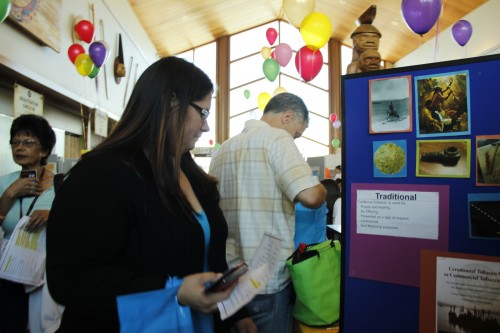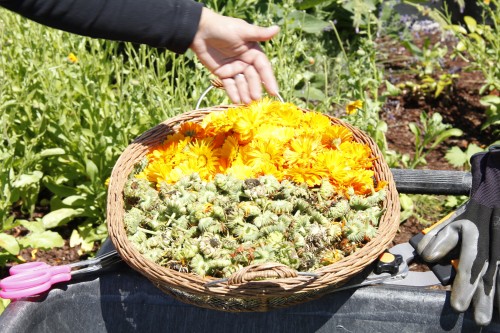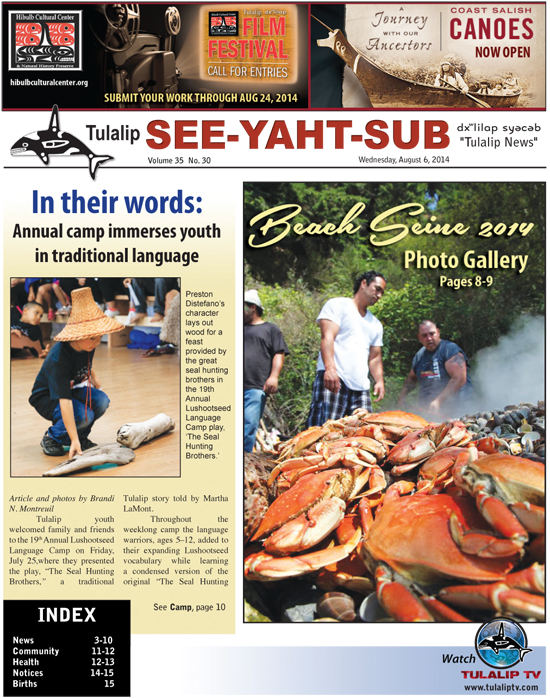Category: Tulalip News
Community Meeting, Healthy Hearts, August 12
National Night Out Draws Large Crowd
By Brandi N. Montreuil, Tulalip News
Tulalip and Marysville Police Departments partnered with Snohomish County Sheriff’s Department to host the Annual National Night Out held at the Tulalip Amphitheater at the Tulalip Resort Casino on Tuesday, August 5.
The national event brings together law enforcement, local organizations, and community members to strengthen relationships to promote crime prevention, while educating community members about crime prevention methods, such as neighborhood watches and citizen patrols.
Traditionally Tulalip Police and Marysville Police Departments have split hosting duties, each taking a turn hosting the event in their respective cities. As this year’s host Tulalip invited local service organizations such as Snohomish County Volunteer Search and Rescue, Tulalip Bay Fire Department, Tulalip Behavioral Health, Medical Reserve Corps, Tulalip Legacy of Healing and others, to participate in the national event that celebrated its 31st anniversary this year.
An estimated 250 community members from the Tulalip/Marysville area attended the event and were able to ask questions about crime prevention and gain crime prevention awareness resources. In addition, were two K9 unit demonstrations that enabled participants to learn how K9 officers search and find drugs.
“Last night’s National Night Out against crime was a success,” Ashlynn Danielson with the Tulalip Police Department. “Events like this one bring together community members and law enforcement to promote crime prevention. We received positive feedback from participants.”
Due to the success of this year’s National Night Out event, Tulalip Police Chief Carlos Echevarria is considering planning an annual Tulalip Community National Night Out.
Brandi N. Montreuil: 360-913-5402; bmontreuil@tulalipnews.com
August is National Immunization Awareness Month
By Brandi N. Montreuil, Tulalip News
TULALIP -August marks a national health campaign to raise awareness on the importance of immunizations. All throughout this month health professionals along with the Centers for Disease Control and Prevention and the National Center for Immunization and Respiratory Diseases are reaching out to communities to educate and promote vaccines.
According to CDC the use of vaccinations could mean the difference between life and death. Some diseases have become rare or have been eradicated through vaccination use, such as smallpox. However the choice to vaccinate is still optional due to no vaccination law enacted by the federal government, other than the requirement in all 50 states that children receive certain vaccinations before entering public schools. Children are required by most states to receive diphtheria, pertussis, polio, measles, mumps, rubella and tetanus vaccines before entering public school, however, medical exemptions can be given if the child has had an adverse reaction to a prior vaccine or is allergic to a vaccine component
During the August awareness campaign the CDC is seeking to decrease the number of people opting out of vaccination by reaching out to communities through education outreach.
“Vaccines have reduced many diseases to very low levels in the United States. For example, we no longer see polio, a virus that causes paralysis, in our country. Not only do vaccines help the patient, they also protect people who come in contact with the patient. Infants and the elderly have decreased immune systems. Being vaccinated helps protect these populations,” said Dr. Jason McKerry with the Tulalip Karen I. Fryberg Health Clinic on the Tulalip Indian Reservation.
This year, Washington State was among 17 other states that experienced a high percentage of measles cases, a first in 20 years. As of July 30, 585 confirmed cases of measles have been reported throughout the nation, 27 of them in Washington. Similarly, cases involving pertussis, or whooping cough, have been on the rise. As of July 26, Washington State Department of Health reported 219 cases of whooping cough, 6 of those reported in Snohomish County, while Grant, King and Pierce Counties each reported 30 or more.
Through the use of vaccinations the risk of infection is reduced. Vaccinations, explains the CDC website, work “with the body’s natural defenses to help it safely develop immunity to disease.” This means vaccinations aid the development of immunity through imitating infection so when the body does encounter the disease, the body will recognize it and fight the infection with antibodies it has created.
“Serious infections like pneumonia, bacteremia, a bacteria infection that gets in the blood and spreads to the whole body, and meningitis, an infection of the fluid that surrounds the brain and spinal cord, can occur with lack of vaccinations. Most of these diseases can be treated with medicine, if caught early enough, but serious negative outcomes can occur if the infection spreads rapidly. These include brain damage, hearing loss, chronic lung disease and even death. It is best to be safe and vaccinate early, before you have a chance to contract a life-threatening disease,” said Dr. McKerry about the risks associated with not vaccinating.
Vaccinations can be administered at private doctor offices, public community health clinics and community locations, such as schools and pharmacies for a reduced price, however most insurance plans do provide coverage cost for vaccinations.
“I always encourage a patient to obtain vaccines from a primary care provider who knows them best and can offer the most current advice on vaccines,” Dr. McKerry said, who went onto to explain that children should be vaccinated before the age of two. “Your child should be vaccinated against hepatitis A and B, rotavirus, a virus that causes severe vomiting and diarrhea. Diptheria, tetanus and whooping cough, haemophilus influenza B, a virus that causes pneumonia and ear infections, among other infections, pneumococcus, a bacteria that causes pneumonia and ear infections, among other infections, and polio, measles, mumps and rubella (MMR), varicella (chicken pox) and a yearly flu vaccine.”
For more information about immunizations or immunization schedules, please visit the website www.cdc.gov/vaccines/schedules/. Or please contact the Tulalip Karen I. Fryberg Health Clinic at 360-716-4511.
Brandi N. Montreuil: 360-913-5402; bmontreuil@tulalipnews.com
National Night Out Returns To Tulalip/ Marysville, Tonight 6 P.M.
By Brandi N. Montreuil, Tulalip News

Photo/ Brandi N. Montreuil, Tulalip News
TULALIP – Tulalip Police Department is partnering with Marysville Police Department once again to host the National Night Out for the Tulalip/ Marysville communities.
This year marks the 31st anniversary for the national event, which seeks to bring community members and law enforcement agencies together to strengthen relationships to promote crime prevention.
Over the years the Tulalip Police and Marysville Police have alternated hosting the event. This year Tulalip Police are hosting at the Tulalip Amphitheatre at the Tulalip Resort Casino, tonight at 6 p.m.
Representative from local organizations are joining Tulalip and Marysville Police Departments, in addition to Snohomish County Sheriff’s Department, to answer community questions about crime prevention and provide crime prevention awareness resources.
The event will feature fun activities for the family, along with food and a raffle.
National Night Out is held annually on the first Tuesday of August and is coordinated by the non-profit organization, National Association of Town Watch. The event involves over 35 million people across 16,124 communities in the nation with a goal to increase awareness, strengthen community relations and send a message to criminals that neighborhoods are organized and fighting back against crime.
For more information about National Night Out, visit their website natw.org.
Brandi N. Montreuil: 360-913-5402; bmontreuil@tulalipnews.com
Tulalip Tribal Member Sentenced To 15 Years In Prison For Second Degree Murder In Death Of Toddler
One Child Dead, Second Critically Injured after Long-time Neglect
Source Press Release: United States Attorney Jenny A. Durkan
Western District of Washington, August 4, 2014
An enrolled member of the Tulalip Tribes was sentenced today in U.S. District Court in Seattle to 15 years in prison and five years of supervised release for second degree murder and criminal mistreatment in the death of one daughter and the neglect of the second, announced U.S. Attorney Jenny A. Durkan. CHRISTINA D. CARLSON, 38, was indicted by the grand jury last May and pleaded guilty in April 2014, following the October, 2012 death of her 19-month-old daughter and the neglect of her 33-month-old daughter. At sentencing U.S. District Judge James L. Robart said, “The details of the murder and mistreatment are nauseating…. She knew she needed to care for her children and she chose not to.”
CARLSON has been in federal custody at the Federal Detention Center at SeaTac, Washington, since January 11, 2013. The criminal complaint and plea agreement describe how on October 8, 2012, emergency crews were called to an address on Marine Drive NE on the Tulalip Tribal Reservation where CARLSON was performing CPR on her 19-month-old daughter who was unresponsive on a blanket on the ground. The child was unconscious, not breathing and covered in urine and feces. A second child, a 33-month old girl, was found strapped in her car seat in a nearby vehicle. The child was pale, unresponsive and covered in urine and feces. The girl was transported to the hospital and later recovered. The 19-month old child died and the Snohomish County Medical examiner classified the manner of death as homicide by parental neglect. According to the report the child was malnourished and dehydrated, weighing only 19 pounds. The child’s skin in the diaper area was excoriated and infested with maggots. Her hair was infested with lice.
The investigation revealed that CARLSON had been living in the car with the girls on the property since mid-September. On October 8, 2012 CARLSON had left the girls in the car while she went to use a phone at the residence on the property. CARLSON admits in her plea agreement that she was away from the car for several hours, attempting to obtain drugs for her personal use. About 20 minutes after the neighbors told her to go back to the car and her children, CARLSON returned asking them to call 9-1-1 because the youngest child was unresponsive.
The case was investigated by the Tulalip Tribal Police and the FBI. The case was prosecuted by Assistant United States Attorney J. Tate London.
August 6, 2014 Tulalip See-Yaht-Sub
Click on the link below to download the August 6, 2014 Tulalip See-Yaht-Sub Issue
Record attendance at annual health fair
Wait lines for health screens and denials at the blood bus

Photo: Andrew Gobin/Tulalip News
By Andrew Gobin, Tulalip News
The Tulalip Karen I. Fryberg Health Clinic hosted their annual health fair July 28, with participants lining up at health screening stations, a fair first in 31 years,.
“I think this is the biggest health fair that we’ve ever had, there have been lines all day,” said Jennie Fryberg, front desk supervisor at the clinic. “More than 280 participants signed in, 200 of which were here before lunch.”
Every year, the clinic holds a blood drive simultaneously with the health fair. This year, more than 20 people had scheduled donor times with the Puget Sound Blood Center’s Blood Bus. Walk-ins are always welcomed at the Blood Bus, but there were so many walk-in donors this year, in addition to those with scheduled times, that for the first time at Tulalip, donors were being turned away due to lack of space. Of the 33 people who tried to give blood, 29 were able to.

Photo: Andrew Gobin/Tulalip News
With a record 35 booths, 8 screening stations, and a fun run, there seemed to be more interest in this year’s health fair than in previous years.
“People were here at 8:30 a.m. waiting for booths to open,” said Sonia Sohappy, a bowen therapist for the clinic’s complimentary medicine program.
The day started out busy, and really stayed comfortably crowded throughout the day. People stopped at screening stations, checking blood sugar, vision, blood pressure, tuberculosis, hepatitis, and more.
The annual health fair is one of many open house events at the Tulalip Karen I. Fryberg Clinic throughout the year. Watch for event announcements in the See-Yaht-Sub, on the Tulalip News Facebook page, or contact the clinic by phone at (360) 716-4511 for more information.

Photo: Andrew Gobin/Tulalip News

Photo: Andrew Gobin/Tulalip News
Andrew Gobin is a staff reporter with the Tulalip News See-Yaht-Sub, a publication of the Tulalip Tribes Communications Department.
Email: agobin@tulalipnews.com
Phone: (360) 716.4188
Tulalip Hosts National Night Out, Aug 5
Black and Blue, the Kangen craze
Water that truly unlocks health, or the latest cure all snake oil?

Photo, Andrew Gobin/Tulalip News
By Andrew Gobin, Tulalip News
You may have seen the blue and black Enagic water jugs people are packing around these days. You’ve probably heard about Kangen water, and if you yourself are not a Kangen user, you’ve probably wondered what exactly is so special about this water from all other filtered waters. The answer to which often leaves people with many more questions about how it all works, or why Kangen is a better choice. Here you will get an in-depth look at this latest health fad.
Many Kangen users tout this water as the new miracle in naturopathic health. Easily absorbed by the body, this water is supposed to keep you hydrated, in addition to being an antioxidant.
Tulalip tribal member Caleb Woods, a Kangen user, said, “I feel more energized, and toxins flush out of my body faster. I notice I sweat easier, and my acne has been clearing up.”
The effects Woods noted are typical of any well hydrated person, so what makes Kangen different? The answer is not so simple.
What is Kangen water exactly? In a nutshell, it is basic, or alkaline. The machine that filters and produces the water is actually a medical machine developed by a Japanese manufacturer 40 years ago. According to Kangen rep, Shawn Brown, water from the city tap or well goes into the machine, is filtered, and then restructured using electrolysis; a process of running an electric current through the water. Water molecules, which are naturally polarized, cluster in a naturally hexagonal structure, similar to a honeycomb. The restructuring of water arranges the molecules into micro clusters of five to seven molecules, instead of the typical 15. That process also ionizes the water, which makes it basic by creating a negative hydroxyl molecule (HO–) and a positive hydrogen ion (H+), or cation. Micro clusters of hydroxyl molecules are more easily absorbed in the body.
The separation of ions of Kangen water raises the pH, which is a measure of the power, or concentration, of hydrogen ions in any compound. The pH scale runs 1-14, 7 being neutral. As the concentration of hydrogen ions increases, the pH number decreases. Acids have low pH, and bases have high pH. Water typically measures at 7. According to the Snohomish County Health District, city water measures at 7.5 because of the lye added to the water to prevent rusting pipes, both hazardous to health in and of themselves. Kangen water is very basic when it’s ionized, measuring between 8.5 and 11, though agitating the water will return it to a neutral state. Also, if not consumed immediately, the natural interaction between the cations (H+) and hydroxyl (OH–) molecules will return the Kangen water to natural water (H2O).
What is the need for alkaline Kangen water?
Brown said, “Cities put a lot of chemicals in the water to kill bacteria, or to make the water healthy. Essentially, that is dead water. Kangen water is not only filtered, but it has free hydrogen ions, which is a natural antioxidant.”
The hydrogen cations are regulators that catalyze chemical reactions in the body’s systems, drawing out free oxygen molecules, or oxidants. In that way, the water is alive, interacting with the body as you drink it. The abundant of cations join with oxidants, neutralizing them. But Kangen water, as a basic solution, disrupts the body’s cells from doing this naturally by inhibiting the mitochondrial processes. The mitochondria of a cell, which govern metabolism in cells and in turn the body, require oxidants in order to metabolize proteins. Hydroxyl molecules join with free radicals making hyperperoxide in the body, allowing the free cations to seek out oxygen and oxidants to join with. That essentially leads to the depletion of oxygen creating a chemical imbalance in the body and a disruption of natural processes at a cellular level. This leads to premature cell death. The body works to regulate itself, and these processes occur naturally without Kangen water.
“The body is naturally alkaline, the blood is alkaline. If the body is acidic, you’re probably sick,” said Brown.
That is true, though not entirely accurate. The ideal pH of blood is between 7.3 and 7.4. So yes, it is alkaline, but only slightly. The body’s many systems help to regulate the pH of the body, each producing acids and bases, specific to each system. While the body is naturally alkaline by design, it is regulated through the secretion of acids produced in the body. Acids, like lactic and stomach acids, are designed to breakdown sugars and proteins, while bases, various hormones, are designed to specifically regulate systems in the body, many of which produce acids. Systems in the body use water to make hydroxyl and hydrogen cations for the purpose of metabolizing compounds and cleaning the body. It is a delicate balance that can have serious health implications when altered.
While it is a delicate balance, deviation of pH levels, even slightly, are signs of serious illness in the body. To do this intentionally has many health implications. For example, deviations in body chemistry of any degree affect metabolic systems drastically. A shock of pH imbalance due to raising the alkalinity of your body could lead to alkalosis. Mild alkalosis causes muscle spasms and cramps. Severe alkalosis can lead to tetanus or cardiac arrest. Acidosis, in contrast, causes mild nausea, vomiting, convulsions, and apnea.
Why does it matter, you may wonder? First of all, Kangen water will be available at all youth summer programs, and at the summer school. Parents should be aware that this is being served to your children. For people with strict dietary needs, there are serious health risks associated with altering body chemistry. That’s not saying Kangen is bad, or shouldn’t be used, but parents should be aware of what their children are exposed to. If people, including children, are on medications, they need to know how Kangen water affects them. The Kangen website and virtual demonstration specifically warn that users should not take medications with the alkaline Kangen water, and should refrain from drinking Kangen for an additional two hours afterward.
Second, there has been a large push that this is the answer to a healthier membership. There is a community Kangen machine available to the public for an hour, mornings and afternoons, at the Don Hatch Jr. Youth Center. Some members have machines in their homes. Kangen can only be acquired through the use of these machines, not sold in stores anywhere. These machines run between $2500 and $4000, and can be acquired through a regional Kangen representative. While the benefits of Kangen may outweigh the risks, the truth is, you don’t need Kangen water to be healthy. Similar results can be achieved through choosing organic foods and eliminating processed foods as much as possible, and expanding your diet to include foods that have specific benefits for healthy function of the body’s systems.
There is no magic cure all to ailments. While you can’t drink your way to health, it is beneficial to drink filtered water. To date, however, there is no documented medical suggestion that says basic water is healthier than natural water, in fact the opposite. Whatever water you choose to drink, the importance is to stay hydrated.
More info on Kangen water available online at www.kangenkarma.com. See the demonstration at www.kangendemo.com.
Andrew Gobin is a staff reporter with the Tulalip News See-Yaht-Sub, a publication of the Tulalip Tribes Communications Department.
Email: agobin@tulalipnews.com
Phone: (360) 716.4188































